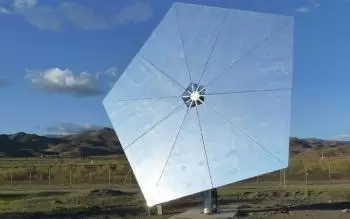
A heliostat is a device that includes several plane mirrors which turn along two axes and serve to direct the sun's rays that fall on them towards a specific direction. The main objective of heliostat fields is to concentrate sunlight toward a predetermined target. The target may be a physical object, distant from the heliostat or a direction in space.
The reflective surfaces incorporate a tracking system to vary the angle of the reflected ray, compensating for the Sun's motion in the sky. According to the heliostat definition, the purpose is to concentrate the radiation constantly at the same point regardless of the Sun’s position.
What are the uses of heliostats collectors?
The heliostat is used in several fields; the most significant are:
-
To generate electricity through solar energy: In solar thermal power plants, the heliostat concentrates the Sun's rays reflected in a fixed point or area distant from the heliostat where the solar collectors are located.
-
In astronomy, this mechanism is used to observe the Sun without changing the observation device's orientation.
-
In the field of geodesy, the heliostat is used to transmit light signals over long distances.
How is the design of a heliostat solar collector?
There are many designs for building heliostats mirrors that vary in efficiency and price.
A simple design allows the mirror to rotate around a polar-aligned primary axis. A mechanical mechanism is responsible for turning the reflecting surface 15 degrees per hour, compensating for the Earth's rotation to the Sun. In this case, the mirror mounted is aligned to reflect solar radiation along the same polar axis in the direction of one of the celestial poles.
On the other hand, another axis allows manual adjustment of the heliostat, so the light declination change over the seasons.
There are also more advanced heliostats with a control system that orients the mirrors to redirect the concentrated solar power to a predetermined target, compensating the Sun's apparent motion. Commonly, the target is stationary relative to the heliostat.
Advantages of heliostats in solar power plants
Indeed, the most important use of heliostats is to get electrical energy in solar thermal power plants. On the other hand, heliostats are also used in photovoltaic plants. Here are the two advantages of this system:
-
We can reach high temperatures in solar thermal plants by reflecting sunlight. In these plants, it is necessary to concentrate solar rays at a point to raise the temperature and pressure of the steam to drive a steam turbine and generate electricity.
-
In the case of photovoltaic solar energy, it allows a tremendous amount of solar radiation to be concentrated on the same solar panel. In this way, it is possible to increase the performance of the PV panel.
-
In photovoltaic systems, the use of heliostats is cheaper because we can reach the same sun-exposed surface using fewer photovoltaic panels.
-
It is economical to make better use of one of the planet's primary sources of renewable energy.
Another aspect to consider in heliostats
Heliostats are not only exposed to the sun but also the wind. Therefore, it implies that the foundations, the structure, the gears, and the entire design must consider the wind loads of the location. In addition, numerous studies show that turbulence occurs in windy areas that generate significant loads on the components of these systems.
Wind effects on heliostats can be divided into static and dynamic wind loading. The static load depends on the square of the wind speed. A way of reducing static charges is to install a porous grid around the perimeter of the reflective module. Thus, flow separation is minimized, and the torque caused by the wind is reduced by up to 40% and about 30% in materials used.
Static loads can also be reduced by placing a horizontal porous grid around the heliostat. Doing this can reduce the horizontal force and torques perceived by up to 40%.